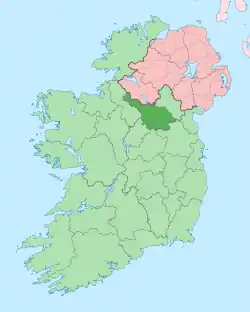Ballyhaise
Ballyhaise (/ˈbæliːˌheɪz/; Irish: Béal Átha hÉis[2]) is a village in County Cavan, Ireland. It is situated some 7 km (4.3 mi) north-northeast of Cavan Town. It is approximately a 15-minute drive or 11 km via the N54 to the border with County Fermanagh in Northern Ireland. The River Annalee flows near the village.
Ballyhaise
Béal Átha hÉis | |
|---|---|
Village | |
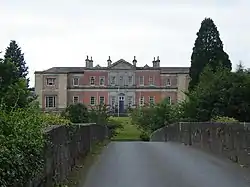 Teagasc Agricultural College, Ballyhaise | |
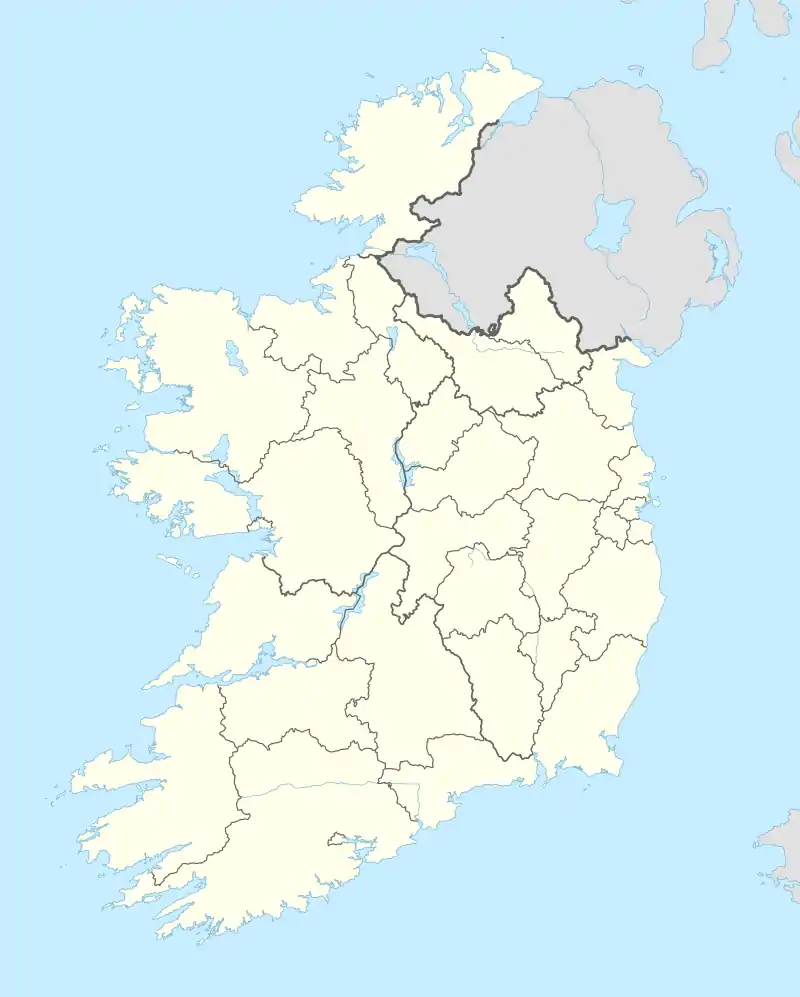 Ballyhaise Location in Ireland | |
| Coordinates: 54°03′N 7°19′W | |
| Country | Ireland |
| Province | Ulster |
| County | Cavan |
| Elevation | 84 m (276 ft) |
| Population (2016)[1] | 711 |
| Time zone | UTC+0 (WET) |
| • Summer (DST) | UTC-1 (IST (WEST)) |
| Irish Grid Reference | H446110 |
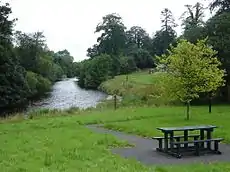
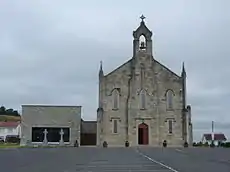
Location
The village of Ballyhaise is located within the parish of Castletara and contains both Roman Catholic and Church of Ireland churches.
History
Ballyhaise has elements of a planned estate village which was built to facilitate a local linen industry in the 1700s. The industry had failed by the 1800s.[3]
Ballyhaise Estate Village
Estate villages were typically known to be villages based around one estate, usually owned and preserved by one family. Originally the Ballyhaise estate belonged to the Taylor family for three generations but was carried into the Newburgh family through marriage. The large proportion of the land of the estate was devoted to Brockhill Newburgh, who built the first stone bridge over the River Annalee which led to Ballyhaise House in 1703. Newburgh built Ballyhaise Castle or Ballyhaise House and made extensive changes and improvements for the estate by plantations and buildings. Newburgh and his two successors created the layout of the village with “great taste”. Through Newburgh and his successors efforts the village and demesne of Ballyhaise was renowned for its beauty. It was said that visitors would travel “far and near” to observe the scenery and buildings in the village of Ballyhaise. The interesting architectural style of the houses in the town along with the castle and grottoes and gardens were all points of attraction in the village. [4]
Notable buildings
Ballyhaise House, situated on the Annalee river (a tributary of the Erne), was built for the Newburghs, a local landowning family, in the 1730s. It is said to contain the earliest surviving oval room in Ireland and Britain. The building was traditionally credited to Richard Cassels, a German architect living in Dublin, who designed many of the capital's finest buildings and squares (including Leinster House). It is more recently thought that Ballyhaise house is actually by the architect of the Irish Houses of Parliament in Dublin, Sir Edward Lovett Pearce.[5]
Ballyhaise House has been used as a Teagasc agricultural college (Ballyhaise College) since the beginning of the 20th century; celebrating its centenary in 2006.
The bridge near the house is reputed to be nearly 300 years old. Ballyhaise bridge was built around 1710. It is made from roughly coursed limestone elevations which have elliptical arches having cut-stone arch rings. The bridge was positioned on a central axis with Ballyhaise House, which acts as a reminder to the formally laid out demesne.[6]
Ballyhaise Market House is a five-bay, two-storey building.
Transport
Bus
Local Link route C1 links the village with Cavan and Butlersbridge several times daily Mondays to Saturdays inclusive. Route C3 from Redhills to Cavan also serves the village with three services each way Mondays to Saturdays.
Rail
Ballyhaise railway station opened on 1 April 1862, closed for passenger traffic on 14 October 1957, and finally closed altogether on 1 January 1963.[7]
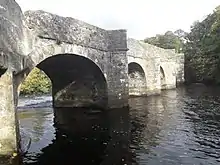
Community and sporting groups
The village is home to Ballyhaise GFC, the local Gaelic football team, their home pitch being Annalee Park. In addition to this, the village was for many years home to Castletara Youth Band - an accordion marching band which won multiple All-Ireland titles in the late 1990s and early 21st century.
Ballyhaise Celtic Football Club was established in the village in 1990. Most recently they opened their home venue, Ballyhaise Celtic Park, located in Glenconnor, Ballyhaise. The club has an established senior team competing in the Cavan Monaghan Senior League and an underage set-up competing in the Cavan Monaghan Underage League.
Weather station
Met Éireann records climate data for Cavan from their station in Ballyhaise.
On 21 December 2010, the maximum temperature recorded in Ballyhaise was -9C and the minimum -14C (average for the day -12C). This was the lowest daily maximum temperature recorded on the island of Ireland since records began in the 1800s.
From Saturday 18 December to Christmas Day (25th) the temperature in Ballyhaise never exceeded -2C and fell to a minimum each day of between -11C and -15C.
| Climate data for Ballyhaise, County Cavan | |||||||||||||
|---|---|---|---|---|---|---|---|---|---|---|---|---|---|
| Month | Jan | Feb | Mar | Apr | May | Jun | Jul | Aug | Sep | Oct | Nov | Dec | Year |
| Record high °C (°F) | 15 (59) |
16 (61) |
21 (70) |
22 (72) |
26 (79) |
29 (84) |
30 (86) |
28 (82) |
25 (77) |
20 (68) |
17 (63) |
14 (57) |
30 (86) |
| Average high °C (°F) | 8.0 (46.4) |
7.7 (45.9) |
9.5 (49.1) |
11.8 (53.2) |
14.8 (58.6) |
17.2 (63.0) |
19.1 (66.4) |
18.7 (65.7) |
16.3 (61.3) |
12.9 (55.2) |
9.4 (48.9) |
7.6 (45.7) |
13.0 (55.4) |
| Average low °C (°F) | 1.7 (35.1) |
1.9 (35.4) |
2.7 (36.9) |
3.7 (38.7) |
6.0 (42.8) |
10.6 (51.1) |
12.1 (53.8) |
11.7 (53.1) |
8.5 (47.3) |
6.4 (43.5) |
3.4 (38.1) |
2.5 (36.5) |
5.6 (42.1) |
| Record low °C (°F) | −9.9 (14.2) |
−7 (19) |
−6 (21) |
−4 (25) |
−1 (30) |
2 (36) |
5 (41) |
5 (41) |
1 (34) |
−4 (25) |
−6.4 (20.5) |
−15.4 (4.3) |
−15.4 (4.3) |
| Average precipitation mm (inches) | 78 (3.1) |
68 (2.7) |
66 (2.6) |
58 (2.3) |
57 (2.2) |
57 (2.2) |
59 (2.3) |
89 (3.5) |
58 (2.3) |
98 (3.9) |
68 (2.7) |
76 (3.0) |
832 (32.8) |
| Average precipitation days | 16 | 13 | 15 | 12 | 12 | 12 | 13 | 13 | 13 | 15 | 14 | 16 | 164 |
| Average snowy days | 2 | 3 | 2 | 1 | 0 | 0 | 0 | 0 | 0 | 0 | 0 | 2 | 10 |
| Average relative humidity (%) | 88 | 85 | 82 | 78 | 77 | 78 | 80 | 82 | 84 | 86 | 88 | 89 | 83 |
| Source 1: | |||||||||||||
| Source 2: | |||||||||||||
Notable people
- The Most Rev. Dr John Crozier, Church of Ireland Lord Primate of All Ireland and Lord Archbishop of Armagh (1911–1920)
- Lisa O'Neill (born 1982), folk singer[8]
References
- Census 2016 Sapmap Area: Settlements Ballyhaise. CSO.ie (Report). 2016. Archived from the original on 13 February 2018. Retrieved 12 February 2018.
- "Béal Átha hÉis/Ballyhaise". Placenames Database of Ireland (logainm.ie). Retrieved 8 January 2022.
- Darley, Gillian (1975). Villages of vision. London: Architectural Press. p. 148. ISBN 0-85139-705-0. OCLC 1921555.
- "History of Ballyhaise". Irish Old News. 5 April 1850. Archived from the original on 27 October 2003. Retrieved 8 December 2021.
- "Ballyhaise Agricultural College, Drumcrow (e.d. Ballyhaise), County Cavan". Ireland: National Inventory of Architectural Heritage. Archived from the original on 9 December 2019. Retrieved 8 December 2019.
- FUSIO. "Ballyhaise Bridge, DRUMCROW (E.D. BALLYHAISE), Ballyhaise, CAVAN". Buildings of Ireland. Retrieved 8 December 2021.
- "Ballyhaise railway station" (PDF). Railscot - Irish Railways. Archived (PDF) from the original on 26 September 2007. Retrieved 11 September 2007.
- Clayton-Lea, Tony. "Lisa O'Neill – Cavan's material girl". The Irish Times. Archived from the original on 3 February 2014. Retrieved 12 January 2020.
| Wikimedia Commons has media related to Ballyhaise. |
